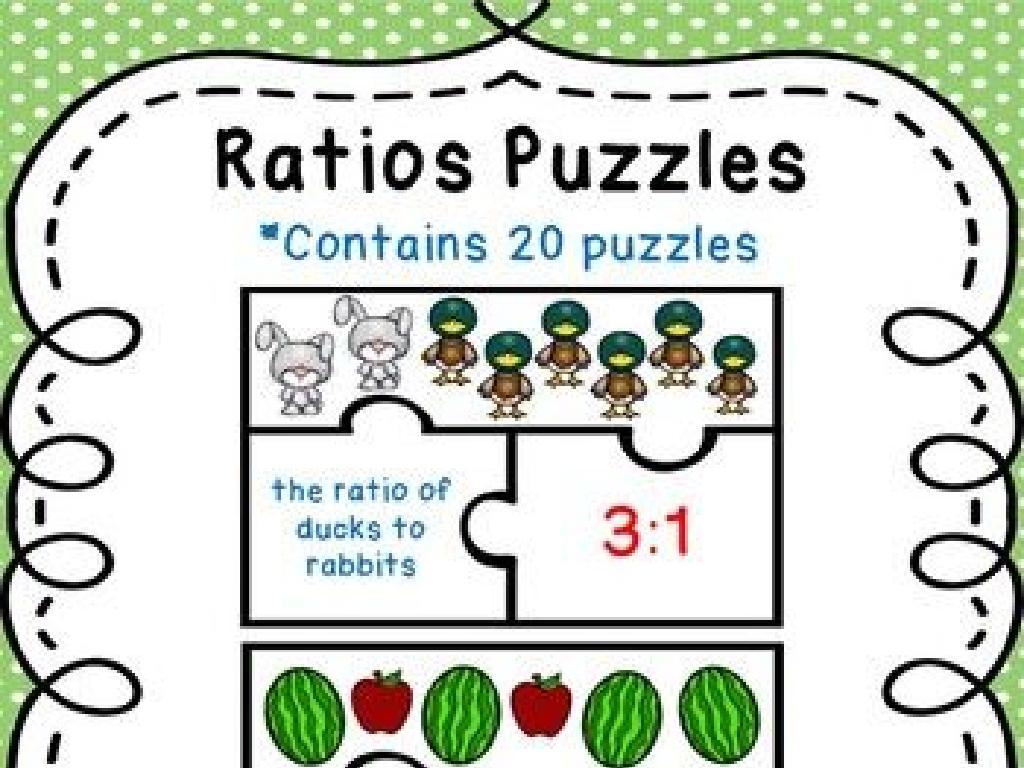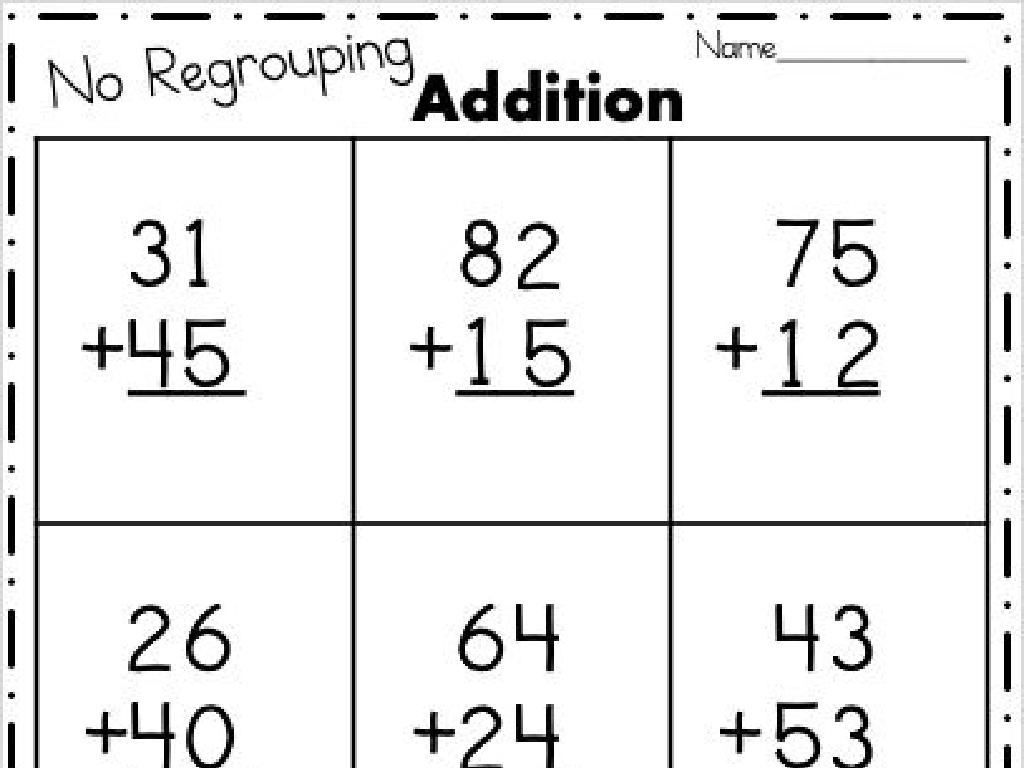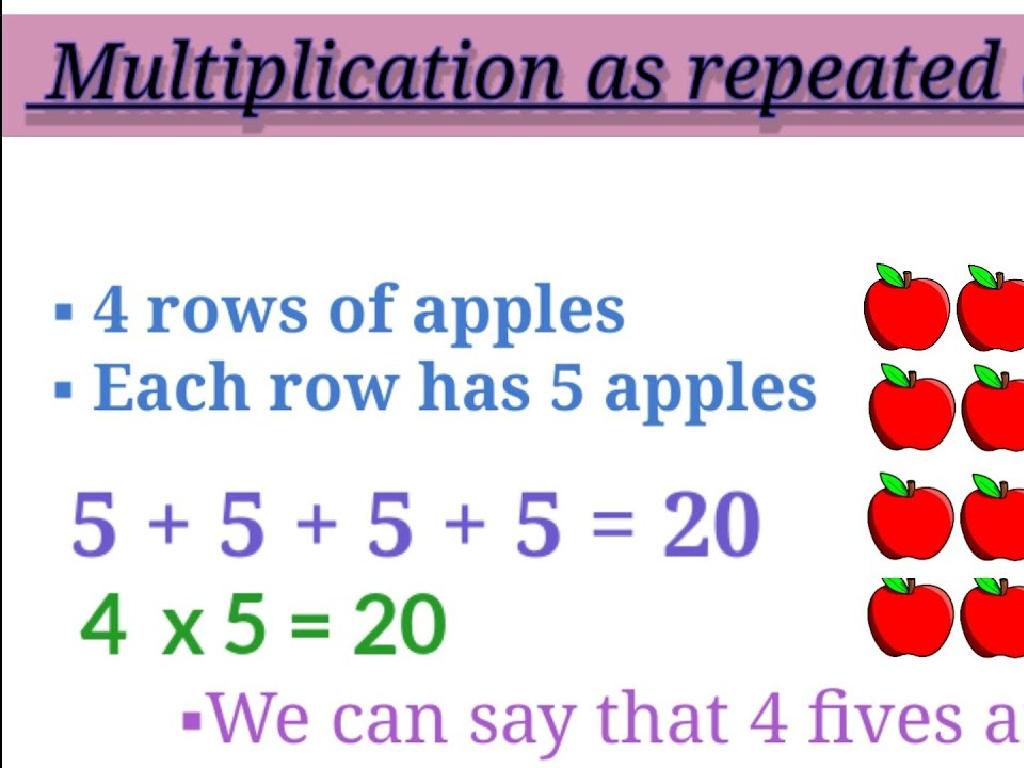Make Ten To Add - With Models
Subject: Math
Grade: First grade
Topic: Addition Strategies Up To 20
Please LOG IN to download the presentation. Access is available to registered users only.
View More Content
Making Ten to Add Numbers
– Learn a fun way to add
– Understand ‘Making Ten’
– Combining numbers to make ten first, then add the rest
– Why ‘Making Ten’ helps
– It simplifies addition by creating easy sums
– Practice with models
– Use blocks or drawings to show 10 and add the extra
|
This slide introduces the concept of ‘Making Ten’ as an addition strategy. The goal is to teach students that by grouping numbers to make ten first, they can simplify the addition process. For example, when adding 8 + 5, make ten by taking 2 from 5 and adding it to 8 to get 10, then add the remaining 3 to get 13. This method is particularly helpful because it breaks down addition into manageable parts, making it easier for young learners to understand and execute. During the lesson, use visual aids like blocks or drawings to demonstrate how to make ten and then add the remaining amount. Encourage students to practice this strategy with different number combinations and provide plenty of hands-on activities to reinforce the concept.
Making Ten to Add
– What does ‘make ten’ mean?
– Use a ten frame to make ten
– A tool to visualize adding to ten
– Combine numbers to total ten
– Add smaller numbers together to get 10
– Examples: 8 + 2, 7 + 3, 6 + 4
– Practice with these pairs: 8 and 2, 7 and 3, 6 and 4
|
This slide introduces the ‘make ten’ strategy, which is a foundational concept in first-grade addition. Start by explaining that ‘making ten’ means combining numbers to reach a total of ten. Use a ten frame to visually demonstrate this concept, as it helps students understand the idea of ten as a base for our number system. Show how different pairs of numbers add up to ten with examples. Encourage students to use their fingers or counters to find combinations that make ten. This strategy will be a building block for more complex addition in the future. Make sure to provide hands-on practice with ten frames or other manipulatives for the students to solidify their understanding.
Making Ten to Add
– Break numbers to make ten
– Take apart numbers to add up to ten first
– Add the leftover to ten
– After making ten, add the rest to it
– Example: 8 + 5
– Take 2 from 5 to make 10 with 8, then add the 3 left
|
This slide introduces the ‘Make Ten’ strategy for addition, which is a foundational skill in first-grade mathematics. The strategy involves decomposing a number to make ten and then adding the remaining part. For example, to add 8 + 5, students can take 2 from the 5 to make ten with the 8. They then add the remaining 3 to the ten. This method simplifies the addition process and helps students to quickly perform mental calculations. Encourage students to practice this strategy with different number combinations and use visual aids like counters or number lines to reinforce the concept.
Let’s Practice Together: Making Ten to Add
– Interactive ‘Making Ten’ example
– We’ll add numbers together to make ten.
– Practice with various numbers
– Try ‘Making Ten’ with 9 + __, 8 + __, etc.
– Class solves problems together
– Work as a team to find answers.
– Encourage participation
|
This slide is designed for an interactive class activity focused on the ‘Making Ten’ addition strategy. Start with a guided example, such as 8 + 5, and demonstrate how to make ten first (8 + 2 = 10) and then add the remaining (10 + 3 = 13). Encourage students to participate by trying different combinations of numbers that make ten. Use manipulatives like counters or blocks to visually support the concept. Have the class work together to solve problems, fostering a collaborative learning environment. Ensure to praise participation to build confidence and engagement. Possible activities: Pair students to solve problems, use number lines, or have a ‘Making Ten’ scavenger hunt with problems around the room.
Fun with ‘Make Ten’!
– Play ‘Make Ten’ card game
– Match numbers to sum ten
– Find pairs like 7 + 3 or 6 + 4
– Work together in teams
– Share your ‘Make Ten’ strategies
– Discuss what pairs you found and how
|
This slide introduces a fun and interactive ‘Make Ten’ card game to help students practice addition strategies. The game involves matching number cards to make sums of ten. Encourage students to work in small teams to foster collaboration and communication. After playing, have a discussion where students can share the different strategies they used to make ten. This will help them learn from each other and understand that there can be multiple ways to reach the same answer. Possible activities include: 1) Pairing up students to find number matches, 2) Creating a ‘Make Ten’ wall chart where students can post their number pairs, 3) Having a ‘strategy share’ circle time, 4) Playing a ‘Make Ten’ memory game, 5) Using manipulatives like counters or blocks to visualize the combinations.
Review: Making Ten to Add
– Recap the ‘Make Ten’ strategy
– Remember how we group numbers to make ten first?
– Discuss its usefulness in addition
– It simplifies adding numbers bigger than ten.
– Answer class questions
– Let’s clear up any confusion together.
– Practice with examples
– Try 9 + 5 by making ten: 9 + 1 + 4 = 14.
|
This slide aims to consolidate the ‘Make Ten’ strategy for addition, which helps students simplify the process of adding numbers greater than ten. Begin by recapping the steps to group numbers to reach ten before completing the addition. Emphasize the strategy’s usefulness in making mental math quicker and more efficient. Open the floor for any questions to address misunderstandings. Finally, engage the class with practice examples, such as adding 9 and 5 by first making ten (9 + 1 to make ten, then add the remaining 4 to get 14), to reinforce the concept.
Class Activity: Make Ten Craft
– Create a ten frame craft
– Use popsicle sticks or straws to build a ten frame
– Practice ‘Making Ten’ with objects
– Place buttons or beads to fill the ten frame
– Show and tell your ‘Making Ten’
– Explain how you added objects to make ten
|
This activity is designed to help students understand the concept of ‘making ten’ in a fun and interactive way. Provide students with craft materials such as popsicle sticks, straws, buttons, or beads. Guide them to construct a ten frame and then use the objects to visually represent the process of making ten. For example, if they place 6 buttons in the frame, they need 4 more to make ten. Encourage creativity and ensure each student has a chance to explain their method during the show and tell. Possible variations for different students could include using different objects or colors to represent different numbers, or creating a larger craft that incorporates multiple ten frames.






